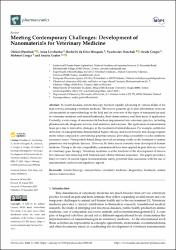Meeting Contemporary Challenges: Development of Nanomaterials for Veterinary Medicine

Göster/
Tarih
2023Yazar
Danchuk, OleksiiLevchenko, Anna
Mesquita, Rochelly da Silva
Danchuk, Vyacheslav
Cengiz, Şeyda
Cengiz, Mehmet
Grafov, Andriy
Üst veri
Tüm öğe kaydını gösterKünye
Danchuk, O.; Levchenko, A.; da Silva Mesquita, R.; Danchuk, V.; Cengiz, S.; Cengiz, M.; Grafov, A. Meeting Contemporary Challenges: Development of Nanomaterials for Veterinary Medicine. Pharmaceutics 2023, 15, 2326. https://doi.org/10.3390/pharmaceutics15092326Özet
In recent decades, nanotechnology has been rapidly advancing in various fields of human activity, including veterinary medicine. The review presents up-to-date information on recent advancements in nanotechnology in the field and an overview of the types of nanoparticles used in veterinary medicine and animal husbandry, their characteristics, and their areas of application. Currently, a wide range of nanomaterials has been implemented into veterinary practice, including pharmaceuticals, diagnostic devices, feed additives, and vaccines. The application of nanoformulations gave rise to innovative strategies in the treatment of animal diseases. For example, antibiotics delivered on nanoplatforms demonstrated higher efficacy and lower toxicity and dosage requirements when compared to conventional pharmaceuticals, providing a possibility to solve antibiotic resistance issues. Nanoparticle-based drugs showed promising results in the treatment of animal parasitoses and neoplastic diseases. However, the latter area is currently more developed in human medicine. Owing to the size compatibility, nanomaterials have been applied as gene delivery vectors in veterinary gene therapy. Veterinary medicine is at the forefront of the development of innovative nanovaccines inducing both humoral and cellular immune responses. The paper provides a brief overview of current topics in nanomaterial safety, potential risks associated with the use of nanomaterials, and relevant regulatory aspects.

















